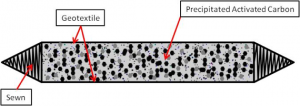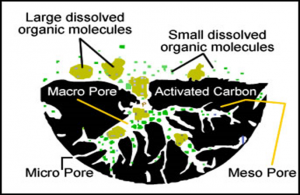Novel Geotextile Mat Tailored to Reduce Odor Emission (H2S) from Landfills
Description
Development of a Geotextile mat using activated carbon enhanced with iron for hydrogen sulfide removal
Project Goals
This project aims to improve environmental and human health through cost-effective removal of hydrogen sulfide (H₂S) from landfill biogas. To facilitate H₂S adsorption, an iron enhanced activated carbon GeoTreat Mat was developed that can be placed on landfills.

Why Activated Carbon?
Activated carbon has historically been used for numerous functions. From preserving organic substances in Ancient Egypt, to shielding soldiers from chemical warfare during WWII, activated carbon has demonstrated its unique properties times and time again. Activated carbon is produced from three primary sources including coal, coconut shells, and wood. Its high surface area and porosity allow it to be an excellent sorbent, ideal for removing harmful pollutants. This research focuses on learning the intricacies of these properties, and finding ways to enhance them for optimal hydrogen sulfide removal. The addition of metals to activated carbon has been shown to increase adsorption. Brita Water, a filtration company, utilizes activated carbon enhanced with silver for optimal water filtration. This research proposes impregnating activated carbon with iron to remove hydrogen sulfide from landfills.

Hydrogen Sulfide (H₂S)
Hydrogen Sulfide (H ₂S) is an invisible, flammable, and toxic gas emitted from landfills through the decomposition of building materials by sulfate reducing bacteria. Though the presence of H2S is typically detected early due to its characteristic “rotten egg” smell, any exposure level can cause adverse health effects. Acute exposure in humans may result in nausea, headaches, delirium, tremors, and convulsions. At high exposure levels, immediate unconsciousness or death has been reported. Hydrogen sulfide emissions also have negative ramifications for the environment, as it reacts with atmospheric oxygen to form the air pollutant sulfur dioxide. Despite these potential adverse effects, as of 2011, the EPA removed the mandate requiring facilities to file TRI (Toxic Release Inventory) reports for hydrogen sulfide. Current removal methods of the biogas are ineffective and costly, so this project also seeks to reduce the monetary costs associated with removal.
Acknowledgements
This project was funded by the Hinkley Center, an organization that specializes in solid and hazardous waste removal. More information about the Hinkley Center can be found below. This research was conducted under the advisement of the Department of Environmental Engineering at the University of Florida.
